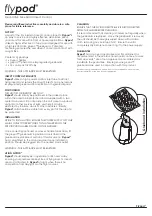
Types de vérins
Types of Cylinders
Instructions de montage
Mounting instructions
VHM 32 DT
VHM 35 DTP
VHM 40 DTP
VHM 40 DTP C254
VHM 50 DTP
VHM 50 DTP C300
A
B
C
D
E
ØF
G
H
I
J
ØK
( Nm)
32 DT
97
444
42
3
9
15
Page 7
Page 7
75
40
8,5
36,30
35 DTP
122
520
51
3
9
15
Page 7
Page 7
85
55
11
36,30
40 DTP
121
537
51
3
9
17
Page 7
Page 7
85
55
11
55,89
40 DTP C254
146
611
51
3
9
17
Page 7
Page 7
85
55
11
55,89
50 DTP
134
583
53
3
13
20
Page 7
Page 7
110
75
13
77,70
50 DTP C300
170
691
53
3
13
20
Page 7
Page 7
110
75
13
77,70
1.
Positionner le bras de mèche,
safran à 0° (idem navigation
en ligne droite).
2.
Présenter le vérin, tige réglée
à mi-course (cote
B
) en
respectant impérativement
les cotes
G
et
H
en fonction
de l’angle du bras de mèche
(voir tableau page 7).
3.
Nous recommandons de
positionner la chape à rotule
du vérin, préalablement
graissée, sur la face
supérieure du bras de mèche
en respectant impérativement
la cote
E
à l'aide d'une
entretoise et la cote
D
(cote
de sécurité). Bloquer l'écrou
( Nm)
de la chape contre la
chape à rotule.
4.
Solidariser le vérin au bras de
mèche et au bateau avec les
visseries appropriées.
1.
Position the tiller arm with
the rudder at 0° (as when
navigating in a straight line).
2.
Position the cylinder with the
rod at half stroke (dimension
B
) and strictly observe
dimensions
G
and
H
which
vary in relation to the tiller
arm angle (see table page 7).
3.
Position the cylinder swivel
yoke, previously greased, on
top of the tiller arm by strictly
observing dimension
E
by
using a spacer and dimension
D
(safety value). Lock the
swivel yoke nut against the
swivel yoke ( Nm).
4.
Secure the cylinder to the tiller
arm and to the boat with the
appropriate screws and bolts.
4


































